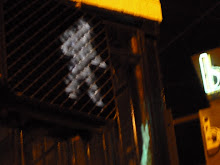Soweto and Apartheid Museum – Jo’Berg
We spent the majority of our 48 hour transit time between Phuket and Tanzania in Johannesburg. Before you get the idea that this was a surprise to us, let me say it was planned and we even had a tour booked to fill the most part of the time that would otherwise have been spent in the Johannesburg airport.
We had seen the Apartheid Museum as part of a travel show on TV while we were still in Seattle and thought it looked like an intriguing way to spend an afternoon. We booked the other half of the tour – through the Soweto township – as a way to see a bit more of Johannesburg. I’m not sure entirely what I was expecting … but I know it wasn’t the crash course in South African history and healthy dose of shame and fear that we got.
Soweto, as it turns out, is not nearly as awful-looking as it seems on TV. Never believe what they tell you in the movies, right? I don’t want to discount the fact that the people who lived there when it was first created were moved there forcibly because the government wanted to be able to control the black people and thought they could do that better in a planned “township” outside Johannesburg city that had plumbing, etc. than in a shanty town. But now it looks mostly like suburbia … perhaps more Tukwila than Issaquah, but suburbia nonetheless.
We spent our time in Soweto going through the Hector Petersen museum and Nelson Mandela’s former house (now a museum). For those who aren’t aware – like I wasn’t – Hector Petersen was a very young black student who was killed in riots that started on June 16, 1976. Those riots were among the first violent acts in a series of events that eventually led to the end of Apartheid. The museum in his honor chronicles the events that led up to Apartheid and the riots in which he was killed. The day we went was June 20, 2006 … shortly after the 30 year anniversary of the riots, so there were lots of school children there to learn about what happened when their parents were young.
The house that’s the Nelson Mandela museum is where he and Winnie Mandela brought up their 3 daughters and where he stayed for 11 days after being released from Robben Island (near Cape Town). Apparently, so many people visited him at all hours of the day and night that he had to move elsewhere. It’s a small 4-room house built by the Apartheid government. Honestly, I was too tired to be much impressed or not impressed by it … it just seemed like a small house. Surprising for someone of Mandela’s current international status, but comfortable and livable and probably huge for the time he lived in it, bringing up his girls.
The Apartheid Museum, where we spent the afternoon, is quite something. It chronicles the history of Apartheid from its early roots to the establishment of the new South African constitution in 1994. It’s filled with photos and film strips and lots and lots of plaques to read about what happened when and to whom, who the major players were, etc. I think the most startling thing to me was watching films of Winnie Mandela urging black people to fight (“we don’t have guns … but we have matches, and we have bottles, and we have petrol”) and then of what happened in the black townships after the government established the state of emergency toward the end of Apartheid rule. The government talks about how it’s the only black government to have been established without war … but the beatings in those films sure look like videos of war to me. The other thing about those state of emergency films was watching them with young black South Africans who clearly had no idea of what they were watching.
Highlights of the new South African constitution are displayed at the end of the museum. It includes, among other things, the right not to be discriminated against because of age, race, sex, creed, sexual orientation, etc. as well as the recognition of 9 tribal languages plus Afrikaans and English as official languages. And then our driver talked about how lots of young people don’t even vote anymore … only 12 years after the first democratic elections. I just don’t know what to think….


0 Comments:
Post a Comment
<< Home